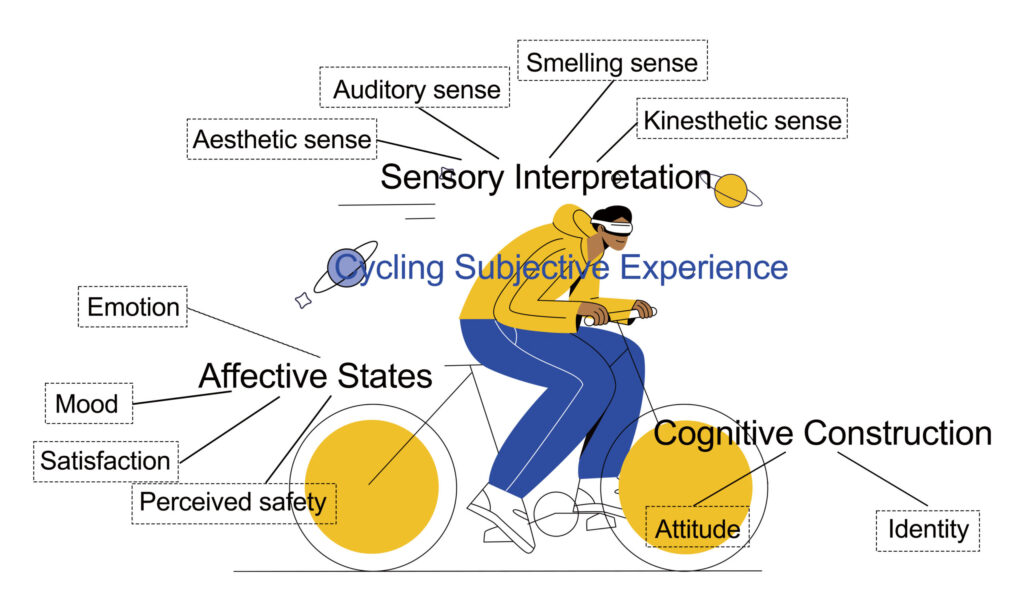Presented October 31, 2019 at the 2nd annual Cycling Research Board conference in Delft, NL
Mobility practices influence children and young people’s understanding of the city that surrounds them. As society develops into insulated bubbles, being underway is one of the few remaining moments in which we engage with social and spatial surroundings. By being less accompanied, children and young people increase their learning of how to negotiate with their surroundings in their own way. Besides the acquisition of ‘spatial knowledge’, the exposure to our social and spatial environments correlates strongly with characteristics such as ‘sense of place’, ‘mutual trust’, and ‘feeling part of a larger whole’ (1).
Backdrop
Growing attention has been given to children’s mobility patterns, mainly in European and North American countries (see for example 2; 3; 4). In the Netherlands, the present generation moves around less independently than their predecessors (3). Recently, Lia Karsten (5) and Naomi Felder found that 85% of trips made by the participating children, from Amsterdam and Rotterdam, were accompanied by a parent or another adult. This percentage falls a bit above the Dutch average of 75% (5). Although the positive impact of independent mobility on children’s development has been known for more than 20 years (2 and 6), motivation for this investigation often stemmed from the awareness of benefits to children’s physical and psychological health (7 and 8). Less frequently, but also, independence has been associated with children’s engagement within their community (9 and 10).
Very fresh publications, such as The City at Eye Level for Kids (11), turn the spotlight more and more to what they call children’s “sustainable development”, meaning a wholesome formation as citizens, which was the main motivation for this study. For children and young people, negotiating their environment and participating in social life are active processes on the everyday level and also termed ‘lived citizenship’ (12). Meanwhile travel, an activity-in-space, is anticipated to increase one’s ‘spatial knowledge’ (13), or the ability to envision and communicate movement and changes of location without necessarily performing them (14). Simply put: ‘spatial knowledge’ is remembering the route. This study explored, more specifically, the ‘spatial knowledge’ acquired through being granted (or denied) independence in the commute to school – as a form of expressing lived citizenship, on a meta-level. It is suggested that when given the opportunity to explore, young citizens become more familiar with their environment, acquiring ‘spatial knowledge’, relevant for the maturation of a sense of responsibility towards the surroundings. This acquired ‘spatial knowledge’ can be communicated via drawings of mental maps of the school routes. The journey to school has recurrently been studied as a main form of everyday travel for children, including via drawings (see for examples 9, 10 and 13).
Approach
In July 2019 at the NEMO Science Museum in Amsterdam, children and young people aged 4 to 16 years old drew their everyday routes to school (n=239) while present caregivers reported on the youngsters’ everyday mobility practices (n=174). The main intention was, again, to contrast a demonstrated spatial knowledge – through the drawings – with children and young people’s mobility habits – as declared by their caregivers. In July 2019, all children and young people who visited the exhibition Fietsen in de Zomer at the NEMO Science Museum in Amsterdam, NL, were invited to voluntarily participate in this study, along with their accompanying adults.
Drawings were made on site, mostly in front of the researcher. Some were collected by friends or colleagues who helped with data collection. The participating children would sit down at a table and receive a sheet of paper on which to draw “what they remembered from the route from home to school”. There were no limitations in terms of time nor paper. Black markers were provided to avoid distraction with color choosing. Some children also used a pink marker to delineate the start and the end, again under the assumption that this would avoid distractions with children wanting to detail their own houses and schools instead of focusing on the route itself. Drawings were handed in right after completion when the name of the city and the country where the route was placed was noted by the researcher, as well as the age of the child, in the upper corner. As soon as they were collected, the drawings would be associated with the respective questionnaire if the caregiver had been present and had filled in a questionnaire.
The dependent variable in this study, assessed via drawings, is named ‘spatial knowledge’. As a concept, spatial knowledge was initially operationalised with the assistance of Annemarie van den Bos and Anna de Jong, at Mijksenaar Wayfinding Agency, in August 2019. The intention was to create a variable that could be studied as continuous, for statistical analysis. Hence the level of detail in each drawing was assessed individually by numerical grading, creating an aggregate dependent variable. Grades were equal to a sum of points, counted from the presence of certain elements such as the road itself and additional details (for example houses and/or trees), in parallel with other subjective elements configuring the urban landscape, as famously defined by Kevin Lynch in 1964 (16).
Questionnaires concerning mobility habits and restrictions of the participating children and young people were filled in by the caregivers at the NEMO Museum while school routes were being sketched by the children / youth. Questionnaires were filled in on site, while parents were sitting at a different table than the children or instructed not to interfere with the drawings. There was a consent form to be signed on the front page of the questionnaire. Pens were provided and time was not restricted. Questionnaires consisted of 39 questions broken in 3 sections: the mobility habits of the child; the habits and characteristics of the family; possible reasons for restrictions to independent mobility. Questions were mostly categorical (n=27) and of multiple choice. All questions have been double checked by a team of senior researchers at the University of Amsterdam, where the researcher conducted an internship at the time. Except for #7 (which was adapted from another study named the PEACH Project, 6), questions follow the original questionnaire from the PSI (15), translated from Portuguese by the researcher.
The explanatory variable in this study is ‘independent mobility’ of the participating children and young people, and it is studied from the perspective of the caregivers, from collected questionnaires. The levels of independent mobility, or levels of independence in the journey to school, from the participating children and young people were directly inquired on the parent’s questionnaires as follows:
1a)How does your child normally go to school? (Check only one box according to the longest, or most representative, part of the way)
- Always accompanied on the route to school
- By a parent
- By another adult
- By an older child
- By a child of same age or younger
- Most of the time is accompanied (for more than half of the trips)
- By a parent
- By another adult
- By an older child
- By a child of same age or younger
- Most of the time goes independently; _____ times
- NO (always goes independently)
The chosen approach to assess independent mobility was that of Hillman et al. (2) and the Policy Studies Institute at the University of Westminster, presented as the most important effort of data collection in the topic (15). The interpretation of the determined levels, as shown above, is unambiguous. Asking for the exact number of times the child goes to school without accompaniment, in case it has been considered infrequent, aids with clarification of the quantifier ‘most of the time’. Nevertheless, the level of independence is measured subjectively: the respondents indicate themselves whether their children go to school accompanied or not, and by whom.
First thoughts about findings
Qualitatively speaking, children who were granted more freedom to move around their cities or villages seemed to detail more their drawings. Preliminary statistical findings seem to further endorse a significant correlation between the granted levels of independence and the spatial knowledge (previously termed spatial awareness by this researcher) of participating children and young people, as assessed in this study.
Data is currently being assessed by the researcher and a publication is expected to follow shortly.
- Te Brömmelstroet, M., Nikolaeva, A., Glaser, M., Nicolaisen, M. S., & Chan, C. (2017). Travelling together alone and alone together: mobility and potential exposure to diversity. Applied Mobilities, 2(1), 1-15.
- Hillman, M., Adams, J., & Whitelegg, J. (1990). One false move: a study of children’s independent mobility. London: Policy Studies Institute. [online] Available at: http://www.john-adams.co.uk/wp-content/uploads/2007/11/one%20false%20move.pdf [Accessed 12 May 2019].
- Karsten, L. (2005) “It All Used to Be Better? Different Generations on Continuity and Change in Urban Children’s Daily Use of Space,” Children’s Geographies, 3(3), pp. 275–290. doi: 10.1080/14733280500352912.
- O’Brien, M., Jones, D., Sloan, D. and Rustin, M. (2000) Children’s independent spatial mobility in the urban public realm, Childhood, 7(3), 257–277.
- Karsten, L., Felder, N. (2016) De nieuwe generatie stadskinderen: Ruimte maken voor opgroeien. Amsterdam, Netherlands: nai010
- Page, A. S., Cooper, A. R., Griew, P. and Jago, R. (2010) “Independent Mobility, Perceptions of the Built Environment and Children’s Participation in Play, Active Travel and Structured Exercise and Sport: The Peach Project,” International Journal of Behavioral Nutrition and Physical Activity, 7(1), pp. 17–17. doi: 10.1186/1479-5868-7-17.
- Schoeppe S, Duncan MJ, Badland H, Oliver M and Curtis C (2013) “Associations of Children’s Independent Mobility and Active Travel with Physical Activity, Sedentary Behaviour and Weight Status: A Systematic Review,” Journal of science and medicine in sport, 16(4), pp. 312–9. doi: 10.1016/j.jsams.2012.11.001.
- Merom, D., Tudor- Locke, C., Bauman, A. and Rissel, C. (2006) “Active Commuting to School among Nsw Primary School Children: Implications for Public Health,” Health and Place, 12(4), pp. 678–687. doi: 10.1016/j.healthplace.2005.09.003.
- Appleyard, B. S. (2005). Livable streets for school children: how Safe Routes to School programs can improve street and community livability for children. In National Centre for Bicycling and Walking Forum (No. 3-7-05, pp. 1-15).
- Ross, N. J. (2007) ‘My Journey to School …’: Foregrounding the Meaning of School Journeys and Children’s Engagements and Interactions in their Everyday Localities, Children’s Geographies, 5:4, 373-391, DOI: 10.1080/14733280701631833
- Danenberg, R., Doumpa, V., & Karssenberg, H. (2018). The city at eye level for kids.
- Lister, R. (2007). Inclusive citizenship: Realizing the potential. Citizenship studies, 11(1), 49-61.
- Matthews, M. H. (1992) Making sense of place : children’s understanding of large-scale environments. Hemel Hempstead, Hertfordshire: Harvester Wheatsheaf (Developing body and mind).
- Tuan, Y.-fu (1977) Space and place : the perspective of experience. Minneapolis: University of Minnesota Press.
- Fagan-Watson, Ben & Shaw, Ben & Bicket, Martha & Mocca, Elisabetta & Elliott, Bridget & Hillman, Mayer. (2015). Children’s Independent Mobility: an international comparison and recommendations for action.
- Lynch, K. (1964) The image of the city. Cambridge, Mass.: M.I.T. Press (Publication of the Joint Center for Urban Studies).



